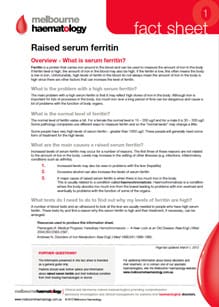Overview
Idiopathic thrombocytopenia purpura (ITP) is a condition that causes low platelets. Platelets are small cells that circulate in the blood that are responsible for preventing bleeding and bruising. Patients with low platelets are at risk of bruising and rarely, serious bleeding.
What causes ITP?
We do not exactly know what causes ITP. In children, we think ITP occurs after a viral infection when the immune system become over active. We do not think this is always the case with ITP.
In adult patients, the increase in bruising and bleeding is usually slow in onset (in children it usually comes on very suddenly after a viral infection).
How common is ITP?
ITP in adults is uncommon; it occurs in approximately 1 in every 16,000 adults per year. This equals about 1500 – 2000 cases of ITP in adult patients each year in Victoria. Many of these cases occur in females between 20 – 40 years of age.
What are the main problems with having ITP?
Platelets are small cells that stop bleeding and bruising.
- The normal level of platelets in the blood is 150 000 – 400 000 per ml of blood.
- These small cells become very sticky when there is a cut or there is a bruise and stop the rest of the blood cells leaking; the platelets form a plug stopping further bleeding.
- If a patient has low platelets then they are at risk of increasing bruising or bleeding. Generally this is not a major problem unless the platelets are less than 30 000 per ml of blood.
How high is the risk of bruising and bleeding?
Most patients with ITP experience only a mild increase in bruising. Some patients may develop small pin point spots of bleeding on the skin called petechiae. Other patients may get more extensive bruising and sometimes bleeding involving the lining of the mouth and nose (mucosal bleeding). Rarely patients may have bleeding in the bowel.
The most serious complication of ITP is bleeding into the brain. The risk of bleeding into the brain is very low.
Does ITP get better?
Although many cases of ITP in adult patients do not get better, the majority of cases do not need any treatment; one study involving 150 adult patients monitored over 10 years showed 93% of patients had an “adequate” platelet count of greater than 30 000 within 2 years from diagnosis; the vast majority of these patients achieved this platelet count without any treatment.
Treatment
What is the treatment for Idiopathic Thrombocytopenia Purpura?
Treatment is generally only recommended when there is more significant bleeding; often bleeding from the mouth or nose. This is always assessed on an individual basis and will need to be discussed with your doctor. The treatment available is known to increase the platelet count BUT does not alter the underlying condition.
The most common treatments are:
What else do I need to do?
Regular blood tests and review with your doctor is generally all that is required – remember most patients with ITP get better; it may just take a bit longer in some patients. There is a support group for patients with ITP available at:
Resources used to produce this information sheet.
- Lilleyman, J “Medical nemesis and ITP” BJH 2003 123 586 – 589
- Bolton Maggs, P “Severe bleeding in idiopathic thrombocytopenia purpura” J Pediatr Hematol Oncol 2003 25 New Engl J Med 1999;341:1986-1995.
Further Questions?
The information presented in this fact sheet is intended as a general guide only.
Patients should seek further advice and information about Idiopathic thrombocytopenia purpura (ITP) in Children and their individual condition from their treating haematologist or doctor.



